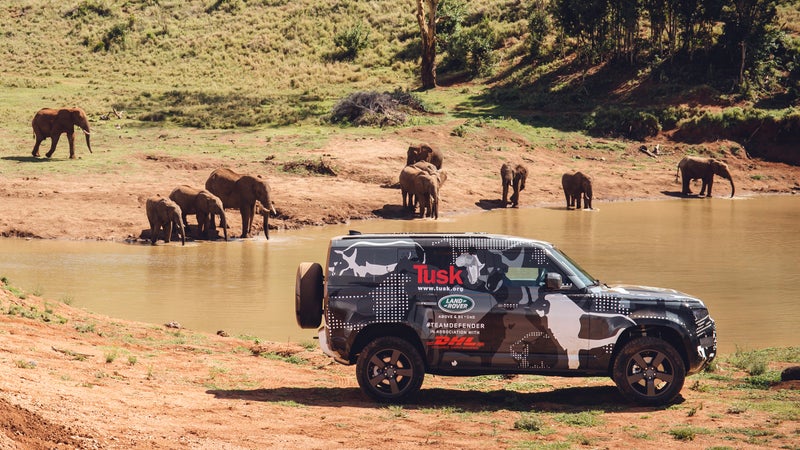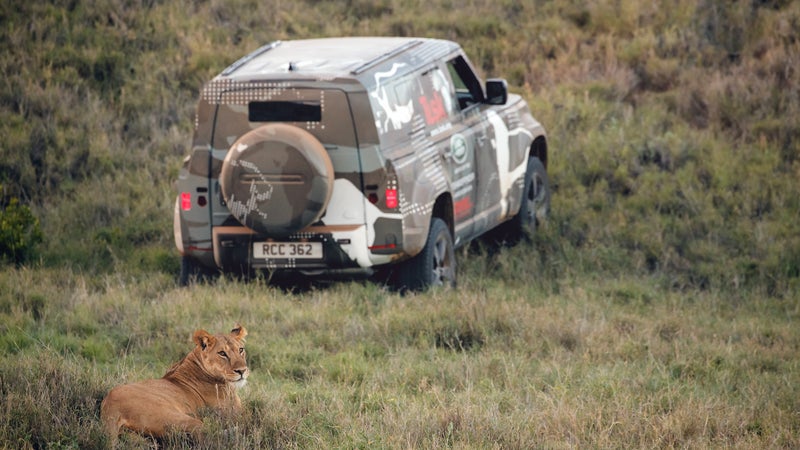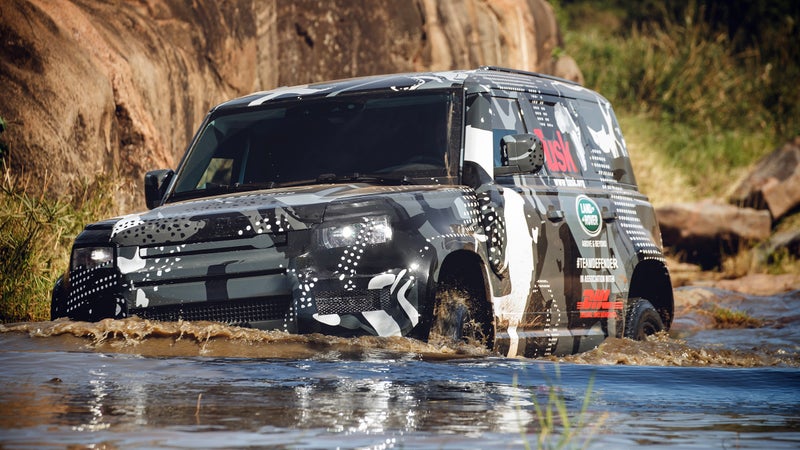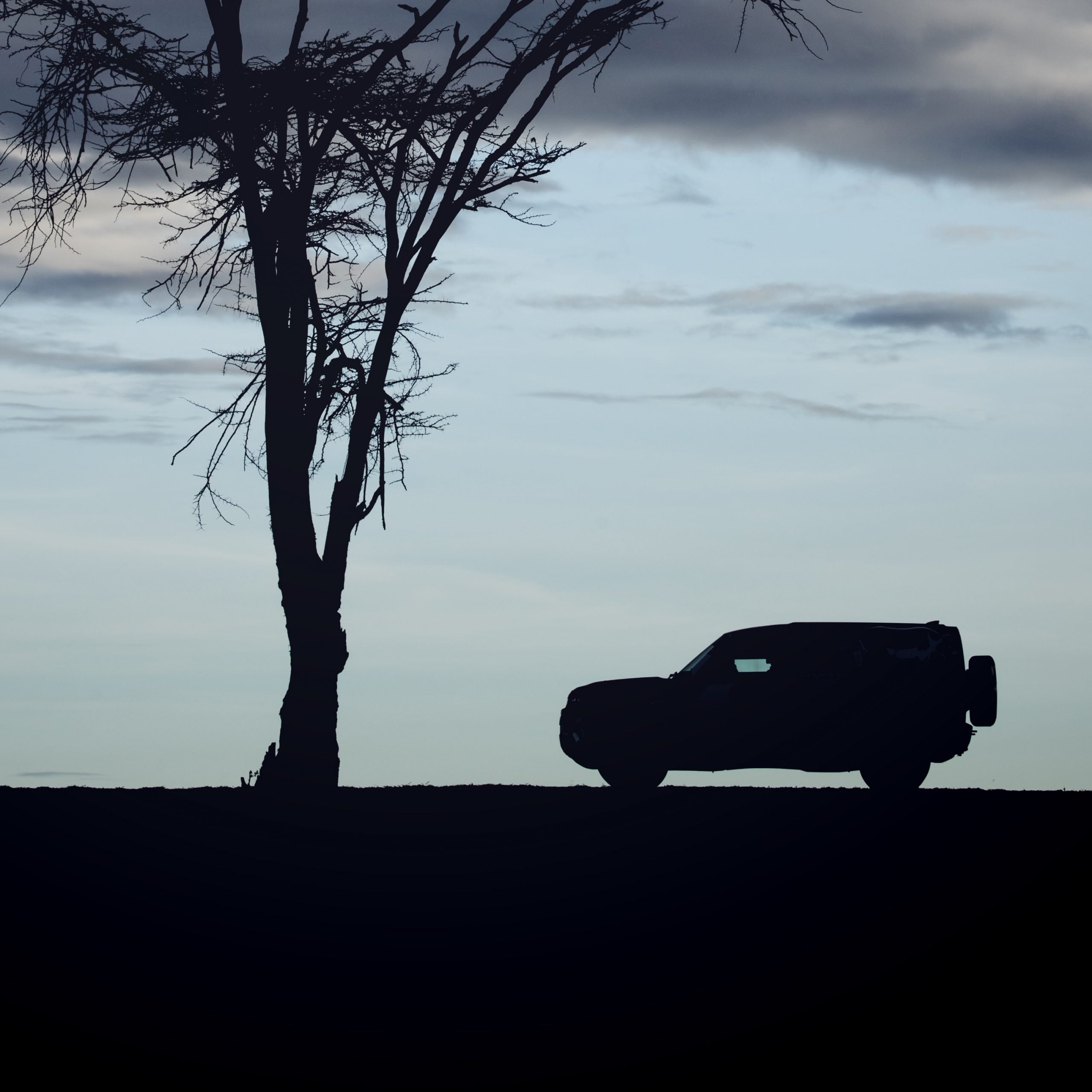The biggest problem when you’re trying to reinvent a famous product? Often it’s the very owners and fans that made your brand legendary in the first place. That’s the trouble Land Rover faces, as it prepares to release a totally new Defender in September. It won’t be anything like the old one, which we think is actually a good thing.
Last sold in the United States back in 1997, the Land Rover Defender now enjoys an almost mythical status among 4×4 enthusiasts. They’ve seen its iconic silhouette on Instagram. They’ve seen these rigs traverse raging rivers during the Camel Trophy competition. Because it was also sold here in very limited numbers, for only a handful of years, Defenders also now command extremely high prices in the used market, often selling for several times their original value.
All that has combined to create a huge level of anticipation for the new Defender, which Land Rover is currently showing in pre-production form, wearing a light disguise, in the run up to its fall release. But while this new model will reference the old with some design elements, key details also reveal a vehicle that couldn’t be more different than the old one. And that is upsetting enthusiasts of the original—largely because most of them have never actually driven one of the old ones. We have, extensively, which is just one of the reasons we’re excited about what’s coming.
Defenders Have Always Been Range Rovers Underneath
Central to the argument of the new Defender’s detractors is that the new model looks like it’s going to share its platform with the current Range Rover. And unlike the old Defender, which was essentially a stone-age farm tool, the Range Rover is a totally modern vehicle with a fully-independent chassis, cross-linked air suspension, industry-leading traction control, and a locking rear differential.
But basing a Defender on Range Rover technology is nothing new. When the original Defender (then known as the Series 110) was first unveiled in 1983, it was built atop the coil-sprung chassis originally developed for the first-generation Range Rover. Back in those days, coil-spring suspension was unheard of in the off-road world. People were afraid of it. Old timey leaf spring suspension was thought to be heavier duty, never mind its poor ride and handling characteristics. Land Rover enthusiasts were so concerned by those new-fangled coils, that Santana, a Spanish company which built re-branded Rovers in Spain, even decided to retrofit its Defenders with leaf springs all the way up to 1994. Eventually, of course, the superior performance of coils overcame the fears of luddites, and the ride and handling benefits they offered are part of what made the Defender so legendary.
Basing the new Defender on the new Range Rover endows it with similarly forward-looking tech. For one thing, this new Defender will actually be getting a factory-fitted locking rear differential for the first time ever. That’s an off-road traction aid so commonplace these days that you’ll even find one on the Fiat-based Jeep Cherokee crossover. In contrast, the old Defender had open differentials on each end, meaning that if one tire lost traction, it basically became a two-wheel drive vehicle. Doesn’t that sound a little ancient?

It’s All About Traction
Land Rover began solving the problem of off-road traction in the mid-1990s through the use of then-new antilock braking systems. Where other ABS systems only detected when wheels would lock up due to brake pressure overcoming traction, Land Rover managed to develop a system that was also capable of working the opposite way—when too much throttle overcame traction, resulting in wheelspin. By applying some brake pressure to a single wheel if it was spinning too fast, Land Rover discovered a way to electronically replicate the function of locking differentials.
The off-road world considered this to be a gimmick. Most enthusiasts didn’t understand how the system worked, and would turn it off rather than take advantage of it. But its advantages were undeniable. Where mechanical lockers can be difficult to engage, expensive to fit, and can reduce a vehicle’s ability to steer around corners when activated, the electronic alternative is affordable and works only in the split-second that it’s needed, requiring no input from the driver. And because they only operate in the moment where traction is lost, they don’t effect steering. Land Rover kept developing the system, even as other manufacturers began to copy it. By 2005, when the Land Rover Discovery LR3 was launched, what was by then called Terrain Response had finally gained a good reputation. In that vehicle, you could dial-in the type of terrain you were crossing, and the traction control system would fine tune its responses accordingly.
Now in its second iteration on the current Range Rover and other models, Terrain Response 2 is even smarter and more capable. Turn that knob and your Land Rover will automatically and continuously adjust its ride height, alter its throttle response, tweak its cross-linked suspension, and turn the rear locker on and off to adapt to whatever challenges the vehicle faces. Off-road, its the most capable Range Rover ever made. Turn that knob back to road mode, and its the smoothest, most quiet, and fastest Range Rover ever too.

Let’s Talk Suspension
In the same way people feared coil springs, they now fear independent suspension—especially independent air suspension.
A solid axle, as fitted to the original Defender, connects both wheels with a solid steel tube. This forces both wheels on the axle to react to any inputs from the driver or terrain. Off-road enthusiasts prefer this because it enables them to predict where the lowest point on their vehicle will be over any obstacle, because that lowest point—the differential housing—never moves. If you slam on the brakes in a solid axle vehicle, the axle itself remains at a constant height, and only the sprung portion of your vehicle (everything held up by the suspension), dives down.
In contrast, independent suspension provides much improved ride quality and handling. But off-roaders don’t like it because ground clearance constantly changes as the vehicle moves.
Spy shots of the all-new Defender, taken while it was doing prototype testing in Moab, show that it is fitted with independent, and height adjustable air suspension. Like Terrain Response, Land Rover first began offering air suspension the mid-1990s, where it quickly gained a reputation as being fragile and unreliable. But also like Terrain Response, 26 years of development have worked wonders.
Now, Land Rover’s cross-linked air suspension systems are able to function both fully-independently, or replicate the pendulum effect of a solid axle, raising one wheel on the “axle” when the other droops down. It also enables an adjustable ride height. Together, these functions enable the same vehicle to excel at high speeds, on the road, or traverse serious off-road obstacles at a crawling pace. That the new Defender won’t drive like a school bus on the road will be a huge leap forward.
Packaging Will Make the Defender Unique
Even Land Rover’s fastest, most luxurious model—the Supercharged Range Rover—is still capable of tackling some of the most challenging off-road trails in the world. We’ve driven that vehicle through trails like Moab’s Hell’s Revenge, Poison Spider, and Seven Mile Rim, and even on terrain that’s more typically the home of built Jeeps, this totally stock, near-$120,000 luxury SUV barely spun a wheel.
But getting a seven-seat luxurymobile through a rock garden requires professional spotters—several of them. The Range Rover is, first and foremost, built to haul people in comfort, and considerations like approach, breakover, and departure angles must be adapted to that need. Judging by these photos of a camouflaged prototype, that’s what the new Defender fixes. It will prioritize the angles needed off-road over passenger space. And that’s all Land Rover really needs to do to make this thing extraordinary: simply allow it to take full advantage of the technology the company has worked so hard to develop.

A Truly Modern Vehicle
Evaluated objectively, the old Defender was awful. You could see daylight between the closed doors and the body they loosely fit in, yet all the glass would fog up the instant there was any moisture in the air. Moisture that, by the way, was free to leak inside as you drove. If that was all that was leaking, then a Defender driver knew that they were on the verge of a breakdown, because all the oil in the engine, the transmission, or the axles must already be gone. The driver’s seat couldn’t accommodate anyone over 5 feet, 9 inches tall, yet the clutch pedal took the strength of a full-grown adult to push. They were so slow, and so ponderous on the road that highways were virtually off-limits, yet required extensive and expensive modification to perform off-road with anything close to the aplomb their image would suggest. And let’s just say their reputation for poor reliability was justified.
Land Rover can no longer afford to trade on its image alone, as the old Defender did for so long. It needs to produce a safe, reliable, modern vehicle that can offer a wide range of drivers both capability off-road, and convenience and ease of use on-road. From a traction standpoint alone it appears as if this new one will be able to go much further than the old. Land Rover has never looked backwards with any of its vehicles; all signs point to this new Defender moving the 4×4 forward into a new era.



